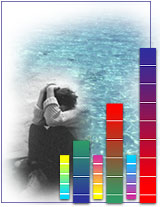Color Psychology

Do different colors affect your mood?
 Related Links |
In our highly visual world, color is everywhere; in the arts, in marketing and design. It shouldn't be a surprise, then, that the impact of color on people can be pretty immense. The use of colors in everyday life can have different psychological effects. The right color choice can make you feel less hungry, or raise your blood pressure. That's why color schemes are very important to companies as part of their brand personality--McDonald's and other fast food chains are closely linked to the color red. At the farthest end, since color affects people's mental health, there's a growing trend of color therapy to help with mood.
Some of effects of color psychology are even baked into the way we talk about colors. In color theory, we designate colors in a lot of different ways. One of the most basic distinctions is between warm colors and cool colors. On a color wheel, warm colors go from red-violet to yellow, and the rest are cool. Now the colors obviously don't have a temperature, but we associate them with different sensations. Desert sands are red and yellow. Shady trees are green, and cool ocean waters are blue. These color associations are what inform our everyday culture.
Now, it's important to note that the psychology of color isn't universal. Different cultures associate things differently, so people's color preferences can change a lot. In fact, cultural differences can change the very colors we see--usually, different exposure is responsible for differences in color perception. For example, if someone doesn't learn the different varieties of the color pink, they will actually see them as the same color, where someone else might see them as different.
Black
The color black is the color of authority and power. Black also implies submission. Priests wear black to signify submission to God. Some fashion experts say a woman wearing black implies submission to men, although other would argue the opposite. Black outfits can also be overpowering, or make the wearer seem aloof or evil. Villains, such as Dracula, often wear black. Separately, it is popular in fashion because it makes people appear thinner. It is also stylish and timeless.
White
Brides wear the color white to symbolize innocence and purity. White reflects light and is considered a summer color due . White is popular in decorating and in fashion because it is light, neutral, and goes with everything. However, white shows dirt and is therefore more difficult to keep clean than other colors. Doctors and nurses wear white to imply sterility.
Red
The color red stimulates a faster heartbeat and breathing. It is also the color of love. Red clothing gets noticed and makes the wearer appear heavier. Since it is an extreme color, red clothing might not help people in negotiations or confrontations. Red cars are popular targets for thieves. In decorating, red is usually used as an accent. Decorators say that red furniture should be perfect since it will attract attention.
The most romantic color, pink, is more tranquilizing. Sports teams sometimes paint the locker rooms used by opposing teams bright pink so their opponents will lose energy.
Blue
The color blue is one of the most popular colors. It causes the opposite reaction as red. Peaceful, tranquil blue causes the body to produce calming chemicals, so it is often used in bedrooms. Blue colors can also be cold and depressing. Fashion consultants recommend wearing blue to job interviews because it symbolizes loyalty. People are more productive in blue rooms. Studies show weightlifters are able to handle heavier weights in blue gyms.
Green
Currently the most popular decorating color, the color green symbolizes nature. It is the easiest color on the eye and can improve vision. It is a calming, refreshing color. People waiting to appear on TV sit in "green rooms" to relax. Hospitals often use green because it relaxes patients. Brides in the Middle Ages wore green to symbolize fertility. Dark green is masculine, conservative, and implies wealth. However, seamstresses often refuse to use green thread on the eve of a fashion show for fear it will bring bad luck.
Yellow
Cheerful sunny yellow is an attention getter. While it is considered an optimistic color, people lose their tempers more often in yellow rooms, and babies will cry more. It is the most difficult color for the eye to take in, so it can be overpowering if overused. Yellow enhances concentration, hence its use for legal pads. It also speeds metabolism.
Purple
The color purple connotes luxury, wealth, and sophistication due to its rarity and its association with Ancient Rome. It is also feminine and romantic. However, because it is rare in nature, purple can appear artificial.
Brown
The color brown is abundant in nature. Light brown implies genuineness while dark brown is similar to wood or leather. Brown can also be sad and wistful. Men are more apt to say brown is one of their favorite colors.
Food for Thought
While blue is one of the most popular colors it is one of the least appetizing. Blue food is rare in nature. Food researchers say that when humans searched for food, they learned to avoid toxic or spoiled objects, which were often blue, black, or purple. When food dyed blue is served to study subjects, they lose appetite.
Green, brown, and red are the most popular food colors. Red is often used in restaurant decorating schemes as a primary color or an accent color because it is an appetite stimulant.
More from Color: Psychology, Symbolism, and Interesting Facts







